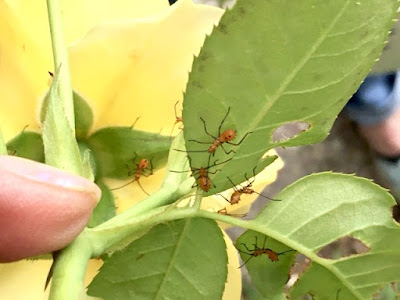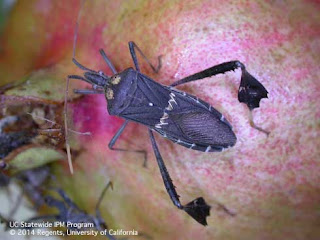
Leaf-footed bugs appear on roses, tomatoes and other juicy plants

|
|
These are leaf-footed bug nymphs. They tend to stay
in a pack when young. (Photo courtesy Alan Moritz)
|
“Good guys or bad guys?” That’s the question that accompanied this photo of mystery insects that suddenly appeared on a rose bush in a Sacramento garden.
Definitely bad guys – and they’re beginning to pop up all over town, especially on tomatoes, soft fruit and roses. The reason? They love triple-digit heat.
Those are nymphs (babies) of the leaf-footed bug, a relative of stink bugs. They'll make holes through your roses (and lots of other things). They’re very bad on tomatoes and can be a pest on apricots and peaches. They also like pomegranates, almonds, pistachios, citrus and watermelons.
Most of their damage is cosmetic, but in big numbers they can be a real nuisance. They puncture the fruit’s skin and suck out its juices.
The good news: They can't fly and they're slow. When young, they stick together. They release a pheromone that keeps the developing bugs in a little pack. (The better to attack your plants.)

|
|
Here's what leaf-footed bugs look like as adults.
(Photo courtesy UC IPM)
|
Like many stink bugs, they're resistant to any pesticides (unless it’s a direct hit). Because the young nymphs are wingless, their instinct is to jump down from wherever they’re dining and scramble for cover.
What to do? Under the plant, put a bucket or dishpan of water with a teaspoon of dish soap (to break the surface tension). Then, gently shake the bush, vine, branch or cane and knock the bugs into the water. (Often, they will just jump when they see your shadow.) They can't swim and they drown.
You also can blast the hell out of them with a hose (you’re watering the plants at the same time). Or you can just squish them, but wear gloves; they'll stain your hands (and they stink).
For more on leaf-footed bugs, check out these recommendations from the UC Cooperative Extension Pest Notes: http://ipm.ucanr.edu/PMG/PESTNOTES/pn74168.html
Comments
0 comments have been posted.Sacramento Digs Gardening to your inbox.
Food in My Back Yard Series
April 22: Should you stock up on fertilizer? (Yes!)
April 15: Grow culinary herbs in containers
April 8: When to plant summer vegetables
April 1: Don't be fooled by these garden myths
March 25: Fertilizer tips: How to 'feed' your vegetables for healthy growth
March 18: Time to give vegetable seedlings some more space
March 11: Ways to win the fight against weeds
March 4: Potatoes from the garden
Feb. 25: Plant a fruit tree now -- for later
Feb. 18: How to squeeze more food into less space
Feb. 11: When to plant? Consider staggering your transplants
Feb. 4: Starting in seed starting
Sites We Like
Garden Checklist for week of April 27
Once the clouds clear, get to work. Spring growth is in high gear.
* Set out tomato, pepper and eggplant transplants.
* From seed, plant beans, beets, cantaloupes, carrots, corn, cucumbers, melons, pumpkins, radishes and squash. Plant onion sets.
* In the flower garden, plant seeds for asters, cosmos, celosia, marigolds, salvia, sunflowers and zinnias. Transplant petunias, zinnias, geraniums and other summer bloomers.
* Plant perennials and dahlia tubers for summer bloom. Late April is about the last chance to plant summer bulbs, such as gladiolus and tuberous begonias.
* Transplant lettuce and cabbage seedlings.
* Weed, weed, weed! Don’t let unwanted plants go to seed.
* April is the last chance to plant citrus trees such as dwarf orange, lemon and kumquat. These trees also look good in landscaping and provide fresh fruit in winter.
* Feed citrus trees with a low dose of balanced fertilizer (such as 10-10-10) during bloom to help set fruit. Keep an eye out for ants.
* Apply slow-release fertilizer to the lawn.
* Thoroughly clean debris from the bottom of outdoor ponds or fountains.
* Start thinning fruit that's formed on apple and stone fruit trees -- you'll get larger fruit at harvest (and avoid limb breakage) if some is thinned now. The UC recommendation is to thin fruit when it is about 3/4 of an inch in diameter. Peaches and nectarines should be thinned to about 6 inches apart; smaller fruit such as plums and pluots can be about 4 inches apart. Apricots can be left at 3 inches apart. Apples and pears should be thinned to one fruit per cluster of flowers, 6 to 8 inches apart.
* Azaleas and camellias looking a little yellow? If leaves are turning yellow between the veins, give them a boost with chelated iron.
* Trim dead flowers but not leaves from spring-flowering bulbs such as daffodils and tulips. Those leaves gather energy to create next year's flowers. Also, give the bulbs a fertilizer boost after bloom.
* Pinch chrysanthemums back to 12 inches for fall flowers. Cut old stems to the ground.
* Mulch around plants to conserve moisture and control weeds.